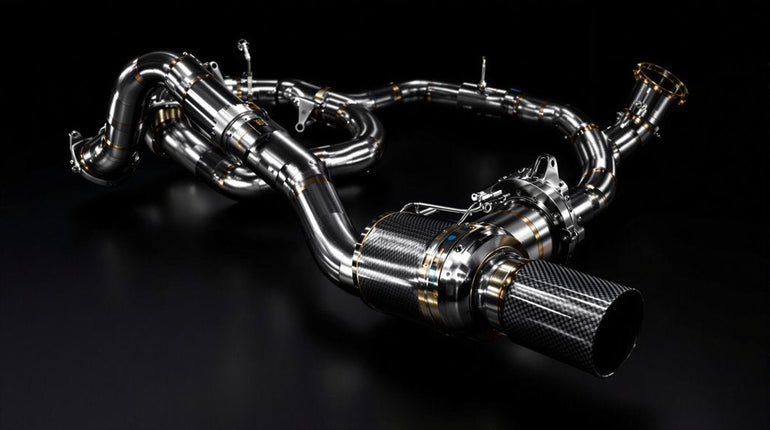A better exhaust system can make your car more powerful by letting engine gases flow out more easily. You can choose from simple changes to the back part of your exhaust, or go for a full system upgrade from front to back. Prices start at $150 and can go up to $3,000 or more. The main parts are the exhaust pipe that connects to your engine, the pollution-control unit, the sound dampener, and the pipe where smoke comes out. Each part helps your car run better and changes how it sounds. Good exhaust systems are made from strong metals like stainless steel, which last longer and make your car sound great. Getting it put in by experts and taking care of it regularly keeps everything working right. Looking at all your exhaust choices helps you pick the best way to make your car better.
Key Takeaways
- Performance exhaust systems enhance vehicle power by improving exhaust flow and reducing internal pressure while customizing sound output.
- Cat-back systems offer an optimal balance of performance gains and cost by replacing components from the catalytic converter to tailpipe.
- Quality performance exhaust systems typically cost between $500-3000, with installation adding $75-200 per hour in labor costs.
- Stainless steel construction provides superior durability and sound quality, making it the preferred material for performance exhaust upgrades.
- Regular maintenance, including monthly inspections for damage and quarterly cleanings, ensures optimal performance and longevity of exhaust upgrades.
Understanding Car Exhaust System Basics
Cars have exhaust systems that help them run better, stay clean, and follow environmental rules. These systems have five main parts: the exhaust manifold, pipes, catalytic converter, muffler, and tailpipe. Each part has its own job in handling the engine's waste gases.
The exhaust system works step by step, first catching hot gases from the engine's cylinders through the manifold. The catalytic converter removes up to 90% of toxins from these exhaust gases.
Then it moves these gases through different parts that clean out harmful stuff and make the car quieter. Custom exhaust solutions can significantly boost your vehicle's overall performance.
When mechanics work on exhausts to make them better, they make sure gases can flow smoothly while still keeping the air clean and the noise down.
This careful setup helps cars run their best while protecting our environment.
Benefits of Performance Exhaust Systems
Performance exhaust systems work better than the basic ones that come with your car, making big changes to how your car runs and feels. These upgrades give your car more power by letting exhaust flow better and reducing the pressure that builds up inside the pipes. The smooth bends and wider pipes help your engine work better and last longer.
These systems also let you pick how your car sounds, with different setups you can add from the middle or back of your car, creating unique engine sounds. Using tough materials like stainless steel means they'll last a long time and weigh less than stock parts. Many drivers enjoy the deep rumbling sound that performance exhausts produce. Just like advanced air intakes, performance exhausts are a key component for maximizing your engine's potential.
Before installing one, you need to check if it fits your car and follows your local rules about car noise and pollution. New design methods and better technology help make these systems work even better at boosting your car's power.
Types of Exhaust Upgrades
Four main types of exhaust upgrades give car owners different ways to make their exhaust systems better. Each type has its own benefits while following exhaust rules. Stock systems come with low factory costs but limit how much power cars can make.
Cat-back systems swap out parts from the catalytic converter to the back of the car, while axle-back changes focus on the rear parts. Header-back systems make big changes throughout, and turbo-back setups work best for cars with turbochargers. Having reliable power systems ensures proper electronic control of modern exhaust components. These custom exhausts range from simple to complex, with different prices and gains in power.
- Cat-back systems keep emissions legal while making cars run better
- Axle-back upgrades give better sound without high costs
- Header-back changes help exhaust flow better
- Turbo-back systems help turbochargers work their best
- The bigger the system, the harder it is to put in
Car lovers can pick upgrades that match what they want in power, what they can handle fixing, and what the law allows, while getting the sound and power they're looking for.
Key Components and Their Functions
Modern exhaust systems have key parts that work together to clean engine gases, cut down noise, and help cars run better. New exhaust designs use better ways to reduce harmful gases while making sure air flows smoothly through the system. Enhanced performance comes from how the system converts harmful gases into safer compounds during operation. Installing high-flow filters can boost engine efficiency by improving air intake and exhaust flow.
|
Part |
Main Job |
How It Works |
|
Exhaust Manifold |
Gathers engine gases |
Shape that helps air flow |
|
Catalytic Converter |
Cleans harmful gases |
Special metals that clean air |
|
Muffler/Resonator |
Makes car quieter |
Sound-blocking spaces |
|
DPF/SCR Systems |
Cuts down pollution |
Uses chemicals to clean gases |
The system starts at the exhaust manifold, which sends gases to the catalytic converter to clean them. The gases then move through parts that make the car quieter, like mufflers and resonators. In diesel cars, special parts called DPF and SCR systems make sure the exhaust meets clean air rules.
Cost and Installation Considerations
Getting a new exhaust system means thinking carefully about what it will cost to buy and put in. The price changes a lot based on what it's made from - regular steel is the cheapest choice but can rust over time.
Putting it in can be tricky, and mechanics charge between $75 and $200 per hour, based on how hard the job is and how skilled they are.
- Parts cost between $150 and $2,000, with stainless steel being the most expensive
- Shop prices differ between muffler shops and car dealers ($250-$600)
- Special designs and tough installations make the total price higher
- High-end systems need special parts and skilled workers
- Parts not made by car makers cost less than factory parts, but quality can be hit or miss
Having experts put in your exhaust means it will work its best and last longer. The metal you pick needs to balance how long it lasts with how much you can spend.
The final price depends on what kind of car you have, how complex the system is, and what extra features you want.
Performance Gains and Efficiency
A better exhaust system can boost your car's power in clear ways that go beyond just the money you spend. The impact of aftermarket exhaust systems on vehicle performance shows that these systems can add up to 10% more power by helping your engine breathe better and push out gases more freely. When your car can move exhaust gases more easily, the engine runs stronger and reacts faster.
Getting the exhaust just right is key - from the parts near the engine to the size of the pipes. Full exhaust upgrades, from the engine all the way back, give you the biggest power boost by letting gases flow better. The science behind exhaust flow dynamics and vehicle power explains that when your engine doesn't have to work as hard to push out exhaust, it uses less fuel. Wider pipes and smooth bends help gases move through more easily.
These changes give real results you can feel: your car responds faster when you hit the gas, the engine breathes easier, and the whole car runs better.
Common Exhaust System Materials
Exhaust systems can be made from different metals, each with its own strengths and weaknesses. Picking the right metal makes a big difference in how well the exhaust works, how long it lasts, and what it costs.
From basic steel to special metals used in race cars, each choice matters for different types of vehicles.
- Regular steel is cheap but rusts easily, so it needs special coatings.
- Stainless steel fights rust better and lasts longer, making it great for powerful cars.
- Titanium is very light but still strong.
- Inconel can handle very hot temperatures, perfect for high-powered engines.
The metal you pick affects how long the exhaust lasts, how heavy it is, and how it handles heat, which changes how the whole car runs.
Sound Enhancement and Control
Changing your car's exhaust parts can make it sound very different. You can make your car sound better by using wider exhaust pipes, new mufflers, or special exhaust tips. Each change affects the sound in its own way - bigger pipes make deeper sounds, while new mufflers can make the overall sound clearer.
To control your car's sound, you can remove resonators, change mufflers, or adjust pipe lengths.
The type of metal used matters too - stainless steel makes sharp, clean sounds. Replacing the whole exhaust system, especially from the catalytic converter back, gives you the biggest sound change and might help your car run better.
Just remember to keep the sound within legal limits and make sure your engine still works well.
Choosing The Right System
Picking the right exhaust system means looking at how well it works and what your car needs. You'll need to check if it fits your car, how much power you want to add, and if it meets the rules for car emissions.
If you want something special for racing or going off-road, custom systems work best. Cat-back systems are easier to put in and follow the rules.
Things to check:
- Pick the right type for your needs (turbo-back, cat-back, or axle-back)
- Make sure it fits your car and matches what the maker says
- Think about how loud you want it and what noise rules are in your area
- Look at how hard it is to install and what it costs
- See if you need to make other changes to your car
A good exhaust system can cost between $500 and $3000 or more.
The best ones from trusted makers give you top power while lasting long and meeting all the rules about emissions.
Maintenance and Longevity Tips
Your car's exhaust system needs regular care to stay healthy. Check for problems often and keep the system clean. Getting help from a skilled mechanic once a year helps catch big issues early.
|
Maintenance Task |
How Often |
What to Look For |
|
Look at System |
Every Month |
Rust, cracks, loose parts |
|
Clean System |
Every 3 Months |
Built-up dirt, blockages |
|
Mechanic Check |
Every Year |
Full system check |
To help your exhaust system last longer, check all parts regularly - especially the seals, hooks, and metal rings that hold it together. Listen for odd noises, as these often mean something is wrong. Most factory-made exhaust systems last 5-7 years, but good care can make them last longer. Fix problems quickly and use good parts that match what your car needs.
Frequently Asked Questions
Can Installing a Performance Exhaust System Void My Car's Warranty?
A new exhaust system won't wipe out your whole car warranty by itself. Car makers must show that your exhaust upgrade directly caused any problems before they can deny warranty coverage for those specific parts.
How Long Does a Typical Professional Exhaust System Installation Take?
The time to put in an exhaust system depends on what kind you want: basic swaps take about 1-2 hours, while high-end systems need 4-6 hours. If your setup needs lots of parts or special work, it might take 8 hours or more to finish up.
Will Cold Weather Affect the Performance of My Upgraded Exhaust System?
Cold weather can make your exhaust system shrink slightly and create more water droplets inside. Better-built upgrade kits handle these winter problems well, but you should still check your exhaust parts often to keep them working their best.
Do Performance Exhaust Upgrades Work Equally Well on Both Automatic and Manual Transmissions?
Performance exhaust upgrades work well for both automatic and manual cars, but manual cars often get slightly better results because drivers can choose exactly when to shift gears and control how the power flows when speeding up.
Can I Switch Back to My Stock Exhaust System After Upgrading?
Yes, you can put your original exhaust back on after trying an upgrade. You'll need to take good care of both systems and watch out for any changes made to the mounting points. Make sure everything lines up right when switching back to avoid problems and keep your car running smoothly.
Conclusion
Performance exhaust system upgrades from Gexhaust represent a significant advancement in automotive enhancement, offering improved engine efficiency, power output, and acoustic characteristics. Through careful selection of materials, components, and design configurations, these systems deliver measurable improvements in vehicle performance metrics. Proper installation, regular maintenance, and consideration of local regulations guarantee peak system functionality and longevity. The investment in quality exhaust modifications continues to be a cornerstone of automotive performance enhancement. Contact us for expert guidance on your exhaust system needs.





